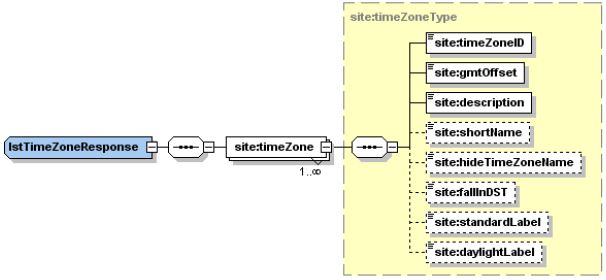LstTimeZone
WebEx partners can use the lstTimeZone command to request information about WebEx time zones. The response provides the offset in minutes from GMT for the specified time zone. Specifying one or more <timeZoneID> values will return the description and GMT offsets for each time zone. Not specifying any <timeZoneID> value returns information for all 62 time zones.
The <date> element specifies the GMT date and time to use to calculate the GMT offsets which change during Daylight Savings Time periods. If <date> is unspecified then the current date and time are assumed.
Request
The sample XML shows an example of a request for the server to return the GMT offset from January 26, 2015, 9:00 PM in time zone 4 (U.S. Pacific Time).
<?xml version="1.0" encoding="UTF-8"?>
<serv:message xmlns:xsi="http://www.w3.org/2001/XMLSchema-instance">
<header>
<securityContext>
<webExID>hostid</webExID>
<password>hostpassword</password>
<siteID>0000</siteID>
<partnerID>9999</partnerID>
<email>johnsmith@xyz.com</email>
</securityContext>
</header>
<body>
<bodyContent xsi:type="site.LstTimeZone">
<timeZoneID>4</timeZoneID>
<date>01/26/2015 21:00:00</date>
</bodyContent>
</body>
</serv:message>
The following schema diagram shows the structure of the elements in the lstTimeZone request message.
Figure 10-15 • Schema diagram for lstTimeZone
For descriptions of the global elements in the security context of the header, see Ch.2, “Global Request Elements in Security Context”. For descriptions of the non-global elements, refer to “Elements in WebEx XML Schema Definitions for the Site Service”.
Response
LstTimeZoneResponse returns information including any Daylight Saving Time offsets in emails and webpages.
The sample XML shows a possible response to the preceding request message (in this example, time zone information for the U.S. Pacific timezone).
<?xml version="1.0" encoding="UTF-8"?>
<serv:message xmlns:serv="http://www.webex.com/schemas/2002/06/service"
xmlns:com="http://www.webex.com/schemas/2002/06/common"
xmlns:ns1="http://www.webex.com/schemas/2002/06/service/site"
xmlns:event="http://www.webex.com/schemas/2002/06/service/event">
<serv:header>
<serv:response>
<serv:result>SUCCESS</serv:result>
<serv:gsbStatus>PRIMARY</serv:gsbStatus>
</serv:response>
</serv:header>
<serv:body>
<serv:bodyContent xsi:type="ns1:lstTimeZoneResponse"
xmlns:xsi="http://www.w3.org/2001/XMLSchema-instance">
<ns1:timeZone>
<ns1:timeZoneID>4</ns1:timeZoneID>
<ns1:gmtOffset>-480</ns1:gmtOffset>
<ns1:description>GMT-08:00, Pacific (San Francisco)
</ns1:description>
<ns1:hideTimeZoneName>false</ns1:hideTimeZoneName>
<ns1:fallInDST>false</ns1:fallInDST>
</ns1:timeZone>
</serv:bodyContent>
</serv:body>
</serv:message>
Figure 10-16 • Schema diagram for lstTimeZoneResponse
The result and exceptionID global elements allow you to confirm that an instantiation request was successful. These elements are described in Ch.2, “Global Response Elements Showing Results and Errors”.

